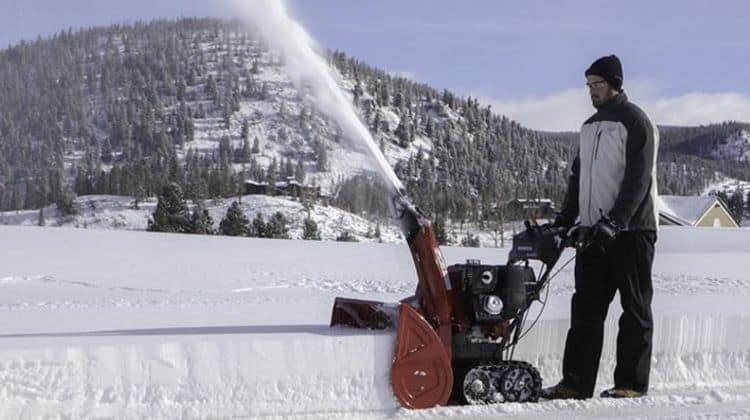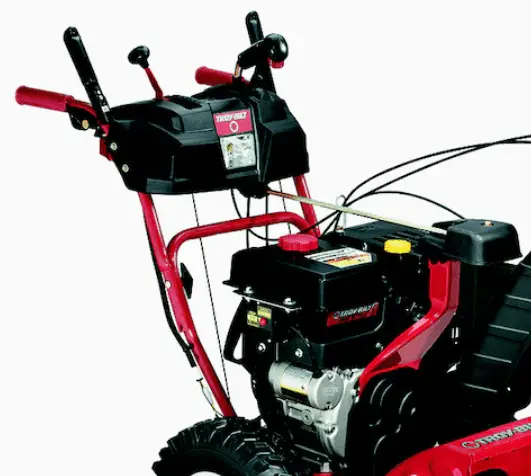In Brief: Snow Blower Buying Guide
Snowblowers come in single-, two-, and three-stage varieties. You can use an electric corded or cordless model for a small driveway, but gas-powered machines perform better for large driveways. Ensure the intake and engine size are adequate for snowfall in your area. Take into account the terrain, and look for ease of use features for maximum comfort.
There are many designs on the market and choosing between them can largely be guesswork if you are unprepared.
This guide will help you decide what type of snowblower fits your needs.
How To Choose The Best Snow Blower for Your Needs
This guide begins with the types of snow blowers on the market, before going more in-depth into the different specifications and features that will affect your decision.
1. Understand Types of Snow Blower Available, and which one is suited best
Snowblowers are sorted into three categories depending on their complexity.
Single-stage snow blowers are the simplest, smallest, and cheapest. You can buy corded electric, cordless electric, or gas-powered models.
The auger directs the snow straight through the chute.
Two-stage snow blowers are gas-powered. The auger collects the snow in the first stage before the impellor blows the snow out through the chute.
Three-stage snow blowers are also gas-powered. They function in much the same way as the two-stage snow blowers, using an auger and an impeller, but they have an extra auger for breaking up dense ice and snow.
Which type you choose will depend on several factors that we will delve into now.
2. How Much Snow Do You Need To Clear?
The main consideration when choosing between these types is how much snow you need to clear.
The single-stage snow blowers are designed to deal with low to moderate snow, so if you only have a few days of snowfall per year and it rarely settles too thickly, then you will probably be looking for a single-stage snowblower.
Two- and three-stage snow blowers are made to clear moderate to heavy snowfall.
The impellor drastically speeds up the process to help you clear snow that would take too long to clear with a single-stage model.
A rule of thumb to follow is that single-stage can handle up to 6”, two-stage can handle up to 12”, and three-stage can handle up to 18”. Check your local weather service to see what the maximum snowfall has been in recent years to gauge which model suits your climate.
3. What Kind of Driveway You Have?
If you have a short, flat, single-car driveway with a hard surface like asphalt or concrete, then a single-stage snow blower suits you perfectly.
However, if your driveway is wider or very long, on a slope, or formed from gravel or dirt, then you will need either a two-stage or three-stage model.
Single-stage models use an auger that scrapes the snow off the ground. If you have a gravel or dirt driveway, that auger will throw debris all over your front yard.
Two-stage and three-stage snow blowers have an auger that retains some ground clearance, making them safe to use on gravel or dirt. They also tend to have engine-driven wheels, making them more suitable for sloped driveways.
The two-stage and three-stage snow blowers are wider than the single-stage snow blowers.
If you have a wider driveway, a wider snowblower will cut down the number of passes you need to clear it.
4. How Much Ice do you plan to Clear? Light Snow, Heavy Snow, & Ice

Finally, which type of snow blower you choose will depend heavily on the type of snow you have to deal with.
Single-stage snow blowers are perfectly capable of clearing large amounts of light snow, but they will struggle with heavy snow and will do nothing to chunks of ice.
Two-stage snow blowers can deal with heavier snow and also clear light snow more quickly. However, they also struggle to deal with chunks of ice.
Three-stage snow blowers utilize an extra auger specifically designed to break up big chunks of ice.
If you regularly get thick, compacted snow and ice on your driveway, you cannot beat the performance of a three-stage snowblower.
5. Engine Type (for Single Stage Snow Blowers)
While two-stage and three-stage snow blowers usually employ a gas engine, you have more of a choice when buying a smaller single-stage snowblower.
You can get the traditional gas engine, or you can opt for an electric model. For electric models, you can choose either a corded or cordless version.
Cordless, battery-powered models are often the least powerful but do offer the most convenience. They start with the push of a button, do not require fuel or oil changes, and are not restricted by a power cord.
Corded models offer a little more power than cordless models on average and do not require a battery to be charged and ready.
However, they are limited by the length of the cord, and they still do not match gas in terms of power.
Gas-powered models offer the most power, without a cord.
They can be more difficult to start, require fuel, and some models also require oil changes. However, many modern models have electric starts and four-cycle engines that do require oil.
6. Intake Size
The height and width of the intake is a key consideration if you have a larger driveway as these determine the amount of snow the blower can deal with at once.
The maximum width you will find on a single-stage snowblower is around 22”. The gas models are the biggest.
On two-stage and three-stage snow blowers, you can find models with clear widths up to around 45”.
The intake height is the depth of snow that the blower can effectively handle.
You should choose a model with an intake height several inches more than the typical snowfall in your area to ensure you will never be outmatched.
If you must choose between height and width, you should prioritize height. A narrow machine will take longer to clear a driveway, but a machine with an inadequate intake height might not function at all.
7. How much Engine Power?

More powerful engines will clear snow more quickly and throw it further from the chute.
For cordless electric models, the power is measured in volts. You will want a 60V machine to get the required power to clear a driveway.
Corded models measure engine power in amps. They are typically available in amperage ranging from 10 to 15 amps, usually depending on the intake size.
Gas-powered models measure their engines in cubic centimeters or cc. They range in power from around 100 cc up to around 220 cc.
8. Chute
The snow collected by the auger gets propelled through a chute. When choosing a snow blower, pay attention to the quality of the chute and its controls.
In terms of material, steel chutes are inferior to plastic chutes. It might sound counterintuitive, but the plastic chutes are not as prone to clogging. Steel chutes can chip and when they do they can begin to rust.
Snow and ice can adhere to the rusted areas, clogging up the chute.
A remote or joystick operated chute can help you to control the direction that the snow is blown. Chute extensions and deflectors can help to reduce blowback.
9. Wheels vs Tracks/Treads
Nearly all single-stage blowers run on wheels, but some of the multi-stage blowers can also run on tracks or treads.
If you choose a wheeled model, look for large, airless wheels for greater traction and reliability.
You might choose a model with tracks or treads if you have some difficult terrain.
Gravel, dirt, and sloped driveways can benefit from a tracked model because they offer greater traction on non-uniform ground.
10. Ease of Use Features

There are many features available for snowblowers that make the job of clearing your driveway a little easier.
Drift cutters can assist in situations where the snow is a little too deep. They help to direct the snow into the auger.
A headlight proves useful for those early morning clears if you need to leave for work before the first light.
Some models have heated handles to keep your hands warm, which is especially important for larger driveways that require more time.
Variable speed controls are available on some two- and three-stage models and allow you to set the drive speed to handle different types of snowfall.
Power steering proves useful for larger snow blowers, especially when pushing through heavy snow.
11. Ease of Storage & Maintenance
In terms of storage and maintenance, you will have an easier time with a single-stage electric snowblower.
They tend to be smaller and do not require much in the way of maintenance.
Larger models can take up a lot of space, with some snow blowers taking up as much room as a lawn tractor, so you should account for how much storage space you have available.
Gas-powered models require fuel stabilizer when they are no longer in use. Failure to add fuel stabilizer will result in the fuel breaking down and damaging the fuel lines and carburetor.
You will also have to consider fuel storage. Fuel must be stored safely, so it is worth planning out where you will keep it before committing to a gas model.
Two-cycle engines will need oil to run. Four-cycle engines are common on new snow blowers, which negate the need for oil.
12. Price Consideration

The most affordable snow blowers are single-stage corded electric models. You can expect to pay somewhere between $150 to $300.
Snow Joe makes a 21” 15 amp corded snowblower, intended for light-duty, priced at around $165.
Cordless models can be more expensive. You must also consider the price of batteries as they will need to be replaced eventually due to degradation over time.
A single-stage cordless 40V model from Snow Joe, with battery and charger, will cost around $340, whereas a 56V model from Ego will cost about $400 without the battery and charger, or $650 with 2 batteries and a charger included.
Gas snow blowers are the most expensive option, with the high-end price points taken by two- and three-stage snow blowers.
A Toro single-stage 18” gas snow blower will run you $450. A two-stage 30” Ariens model with a big 306 cc engine might cost you about $1500, and a Cub Cadet 3X three-stage model, complete with a 420 cc engine and a 30” clear width could run you $2200.
Check Best Single Stage Snow Blowers here>
Check Best Two-Stage Snow Blowers here>
Check Best Three-Stage Snow Blowers here>
Summary
We hope that this guide has helped you decide which type of snow blower you need and given you an idea of the features you should be looking for.
Now that you know what to look for, you should be able to make a buying decision with complete peace of mind.
If you have any questions or comments about this guide or snow blowers in general, please feel free to leave them in the comments section below.


